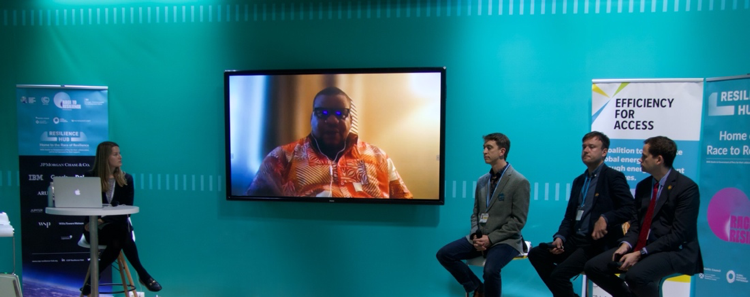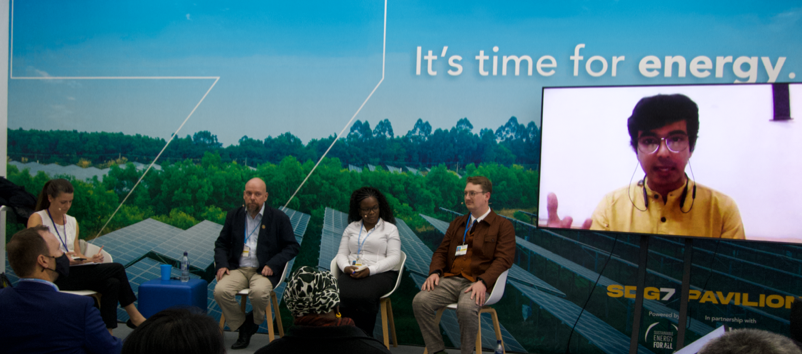Reflections from COP26: Six Takeaways for the Future of Off-Grid Appliances
Written by Sarah Hambly, Energy Saving Trust and Joanie Coker, CLASP (Efficiency for Access co-Secretariat)
COP26, possibly the world’s best chance to get climate change under control, ran from 1 – 13 November and featured many reflections and events that demonstrated how energy access and energy efficiency are important considerations for the climate agenda. The Efficiency for Access team was delighted to attend COP26 and organise three events at the Resilience Hub and the SDG7 pavilion. We were also endorsed by world leaders as a leading initiative for international collaboration as part of the Glasgow Breakthrough on Power. In no particular order, here are our six key take-aways from this momentous conference.
1. An unprecedented influx of funding for clean energy access
In the first week of COP26, we were inspired to see the launch of major new philanthropic and aid funded initiatives in clean energy access. Of particular note was the Global Energy Alliance for People and Planet, which launched with an impressive $10 billion investment, including $1.5 billion in philanthropic funding from the IKEA Foundation, Rockefeller Foundation and Bezos Earth Fund.
In addition, the UK aid announced £126 million of scale-up funding for the Transforming Energy Access (TEA) platform. With this new investment, the TEA platform aims to reach 25 million people with improved clean energy access by 2026, leverage £1.3 billion of investment and create 170,000 new long-term green jobs by supporting clean energy access solutions in Asia and Africa.
The level of investment needed to achieve energy access for all has consistently fallen far short of what is needed. These and other such initiatives announced at COP26 signal a transformative step on our path to SDG7 and, of most interest to Efficiency for Access, the development of affordable, efficient and inclusive appliance markets reaching those who need them most.
2. Leaving no one behind
As many donors and other stakeholders in the off-grid space turn their sights to productive uses of energy and unlocking higher tiers of energy access, there is growing concern for the populations that may be left behind. There are hundreds of millions of people without energy access who cannot afford simple solar lighting solutions, let alone a productive use appliance like a refrigerator or solar water pump.
On 5 November, more than 30 nations adopted the Just Transition Declaration, recognising the need to ensure no one is left behind in race towards Net Zero. When we consider a just transition in the context of universal access to clean energy, it is important that we don’t lose sight of the populations still needing access to the bottom rung of the energy ladder.
“Solar home systems and lighting are the amino acids of the off-grid solar sector,” said Leslie Labruto, Head of Investment Strategy at Acumen on a panel in the SDG7 Pavilion. “We have to be careful that we don’t ignore those building blocks and leave our backs to the part of the industry that is serving the most people in need.”
3. Adaptation and resilience – an increasing focus for the off-grid appliance sector
Mitigation has traditionally been a key focus of energy access efforts, in view of the sector’s contribution to avoiding greenhouse gas emissions. However, off-grid appliances can play an important role in helping vulnerable communities adapt to the effects of climate change. It was heartening to see that COP26 helped to emphasise that adaptation cannot be the neglected half of the climate equation.
The conference saw the emergence of impressive monetary commitments to support adaptation and resilience. On 9 November (Science and Innovation Day at COP26), the GSMA announced the launch of the GSMA Innovation Fund for Climate Resilience and Adaptation, which will help accelerate the testing, adoption and scalability of digital innovations that enable the world’s most vulnerable populations to adapt, anticipate and absorb the negative impacts of climate change.
Equally, Efficiency for Access’ events at the Resilience Hub sought to highlight the talented people and organisations around the world who are creating innovations that can help enhance clean energy access and assist vulnerable communities to build climate resilience and withstand external shocks. Our Programme Partner GOGLA is also doing important work in this space with its ‘Power 1 Billion Lives by 2030’ compact, which emphasises the connections between off-grid solar and climate resilience. Check out GOGLA’s key takeaways from the conference here.
These are just a few of the funding announcements and awareness raising efforts at COP26 that are positioning the energy access sector as a pivotal contributor to climate adaptation, in addition to mitigation. As the off-grid solar sector seeks to serve many of the most climate-vulnerable on the planet, we expect the themes of adaptation and resilience to become staples of the energy access agenda in the coming years.
4. The (under)value of local entrepreneurship
In our Efficiency for Access panel on 4 November, critical voices from the off-grid solar appliances industry, including Nnaemeka Ikegwuonu of ColdHubs, observed that a disproportionate level of financing is being directed to foreign-owned companies rather than local enterprises. In fact, according to GOGLA’s Off-Grid Solar Investment Trends 2019-2020 Report, around 75% of all funding commitments into the sector went to only three international companies in 2020.

Local clean energy entrepreneurs offer the most immediate, on-the-ground insights into the needs of off-and weak-grid communities. Therefore, companies are calling funders to modify their investment criteria and prioritise engagements with local enterprises to achieve sustainable and robust impact. “The volume of financing going to large-scale foreign companies needs to be redirected to local enterprises,” said Nnaemeka. “Unless this is done, achieving and realizing sustainable clean energy markets will only be a mirage.”
Chris Beland, another speaker on our panel and head of the Efficiency for Access Research and Development (R&D) Fund, also spoke to the importance of shifting focus (and funds) towards local enterprises. Currently, 30% of the organisations supported by the R&D Fund are managed by local clean energy entrepreneurs and the Efficiency for Access team is committed to increasing the ratio of local engagements in the future. Explore in this article from our partner Power for All for more on equity and employment in the off-grid solar sector.
With so many new and exciting funding opportunities being announced at COP26, it will be interesting to see whether (and how) local enterprises are being factored into the equation.
5. Energising young people who are on the frontlines of climate action
We welcomed so many talented young people take their much-deserved seat at the table in discussions throughout the Blue and Green Zones at COP26 and outside the conference. The question of empowering young people to address climate change and achieve universal clean energy access was also prominent in discussions. Eduarda Zoghbi, a representative of Student Energy, made a clarion call for young people to be included in the creation of bottom-up solutions.

At Efficiency for Access, we believe that young people can be an important part of efforts to achieve universal clean energy access and combat climate change in the long term. According to recent estimates, there are 1.8 million young people aged 10–24, which the UN believes represents the largest generation of youth in history. They are acutely aware of the climate emergency that the world is facing and are working on the frontlines of climate action to develop bold and original solutions. We can further empower young people to address the climate emergency and achieve universal energy access by helping them gain the skills and experience to create appliances for remote and rural communities. This inspired the creation of the Efficiency for Access Design Challenge, which has seen over 150 students submit projects focused on a range of products, from solar-powered oxygen concentrators to highly efficient mills.
6. Clean cooking, an often-overlooked climate solution, comes to the fore
A panel moderated by Dymphna van der Lans, CEO of the Clean Cooking Alliance, signaled to all that clean cooking needs to be at the forefront of conversations on climate action and sustainable energy transitions. “No serious conversation can be had about achieving SDG7 or any of the other SDGs for that matter, without consideration for women and girls with a major focus on clean cooking solutions at all levels within the value chain,” said H.E. Samira Bawumia, Second Lady of the Republic of Ghana.
On 3 November, the UN released a new Global Roadmap for Accelerated SDG7 Action that includes a 2025 milestone for 1 billion more people to gain access to clean cooking solutions on the road to 2030. Contributing to this ambitious target, the Government of Rwanda launched an Energy Compact on Clean Cooking later that day that aims to accelerate access to modern cooking solutions across the country. The compact aims to reduce the use of open fires for cooking by 80% in rural areas and ensure that at least 50% of urban populations have access to efficient, clean cooking fuels.
There was also further mention in the SDG7 Pavilion related to the second wave of the multi-donor Universal Energy Facility, a 500 million-dollar results-based financing (RBF) facility managed by Sustainable Energy for All. The facility’s first wave is currently stimulating Africa’s off-grid electricity development and the second wave will aim to do the same for clean cooking. Specifically, the facility hopes to deliver 300,000 new clean cooking solutions by 2023. Another clean cooking RBF facility is being implemented by Global LEAP Awards team at Efficiency for Access. To date, the facility has incentivized the sale of over 3,770 electric pressure cookers in Kenya, reaching an estimated 18,865 beneficiaries.
Progress on achieving universal access to clean cooking has been too slow to date, so it is great to see the topic take centre stage in so many of conversations and new initiatives announced at COP26.